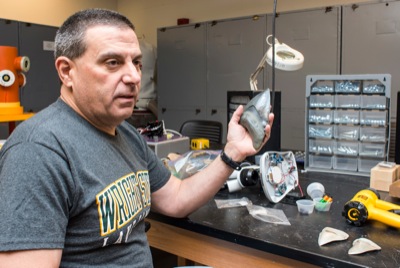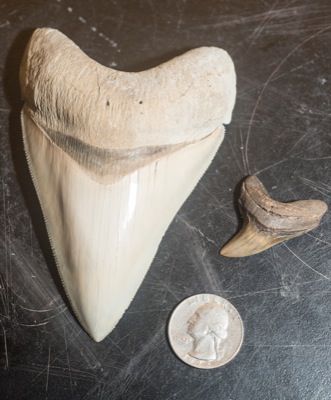Friday, September 15th, 2017
Knowledge of ancient shark puts spotlight on professor
By Sydney Albert

Photo by Mark Pummell/The Daily Standard
Professor Chuck Ciampaglio of Wright State University-Lake Campus displays a cast of a megalodon tooth more than 6 inches long, one of the largest ever found. Ciampaglio estimated the animal to which the tooth belonged could have been more than 60 feet long.
CELINA - Every week is Shark Week for Professor Chuck Ciampaglio of Wright State University-Lake Campus.
His lab is filled with collections of shark artifacts, a mixture of teeth from modern times and fossilized shark parts that date back millions of years. Ciampaglio estimates he's written about 50 papers on sharks and shark evolution, some of which have helped him catch the attention of TV channels such as National Geographic, Discovery and Smithsonian. He's particularly famous for his work on the giant prehistoric shark, the megalodon.
Ciampaglio called megalodon the biggest predator that ever lived. He said a fully grown megalodon could have had about 300 teeth in a jaw bigger than an average household doorframe and could grow to be about 60 feet in length.
The paper that initially helped him garner attention in the academic community and catch the eye of educational TV channels was on the evolutionary relationship between megalodon and modern great white sharks. The supposed similarity between the two sharks has been a source of contention in the scientific community for a long time, Ciampaglio said.
"The great white was supposedly the living (descendent) of megalodon, and we've done a lot of work to show that that's really not the case at all," he said.
While working on his Ph.D. at Duke University, Ciampaglio decided to research the subject. He looked at almost 500 teeth from different species, measuring them and performing a three-dimensional data analysis, applying math to the question of the evolutionary link between the species.
In the process, he found that great whites are actually more closely related to mako sharks. Though modern makos don't have serrated teeth, he explained, going back in the evolutionary line, some mako sharks did, and their teeth are more similar to that of a great white.
When his paper was published in the Journal of Vertebrate Paleontology, it was well received and well cited. Later, when National Geographic began to develop an hourlong show on the megalodon, producers asked him to explain the ancestry of the shark and to help them build a model that could show the attack mechanics of the jaws.
A few years later, Discovery Channel was making a show for Shark Week, and producers enlisted his help to build a life-sized model of megalodon jaws, a contraption of steel and hydraulics. Discovery Canada also has talked with him about shark evolution and how fossils are retrieved from rock.
Most recently, the Smithsonian Channel got in touch with him a few months ago, asking that he re-create the jaw mechanism on a smaller scale than the one for Discovery and help them demonstrate it. He filled PVC tubes with a gelatin mixture, strips of wax to simulate cartilage, bags of blood and wrapped them with a silicone skin. The powerful jaws and serrated teeth of the mechanism were easily able to break the faux prey in half, he said.
"Everybody assumes that when those jaws come down, it just snaps something in half. If it's small enough, maybe. But the real power is, when it snaps down, it makes some dangerous wounds, but the shark then shakes. It thrashes, and the thrashing with those serrations just cuts everything right in half," Ciampaglio explained.
The Smithsonian show, which he predicted would air in December or January, is about the top 10 predators of all time and features another predator that lived in the Ohio area called dunkleosteus.
Though he's become quite accomplished in his field, Ciampaglio says he wishes he'd started earlier. He worked as a mechanic from the ages of 17 to 30, even owning his own car shop before he decided he wanted to go to college. Not being able to settle on one degree, Ciampaglio worked on two degrees in six years, earning bachelor degrees in physics and chemistry. It had been quite a change, but he knew after the first year that he wanted to stay in school, he said. He later went on to earn his master's degree in zoology and his Ph.D. in paleontology.
Ciampaglio says he likes teaching at the smaller Lake Campus because he's able to really make the space his own and can build better relationships with his students. Whether or not class is in session, students are almost always in his lab working on something. Every other year he teaches at Wright State's Dayton campus, and he says he can draw hundreds of students.
Even so, he's never used the shows on which he's appeared as a teaching tool. Students have usually already seen them, he said.

Photo by Mark Pummell/The Daily Standard
A megalodon tooth sits next to a modern shark tooth and a quarter for scale. The serrated edges of a megalodon tooth enabled the animal to bite into prey and split through tendon and bone with a shake of its head.



